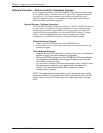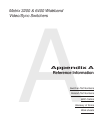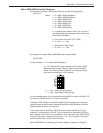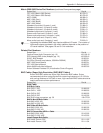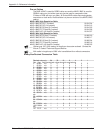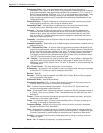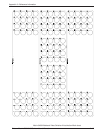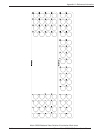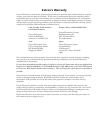
Appendix A • Reference Information
Extron • Matrix 3200/6400 Series • User’s Manual
SECAM – Sequential Couleur Avec Memoiré – Translated as “Sequential Color with
Memory”. A composite color transmission system that potentially eliminates the need
for both a color and hue control on the monitor. One of the color difference signals is
transmitted on one line and the second is transmitted on the second line. Memory is
required to obtain both color difference signals for color decoding. This system is
used in France, Africa, Asia and many Eastern European countries.
Serial Port – An output on the computer that allows it to communicate with other devices
in a serial fashion – data bits flowing on a single pair of wires. The serial port is most
often used with RS-232 protocol.
SMPTE – Society of Motion Picture and Television Engineers – A global
organization, based in the United States, that sets standards for base-band visual
communications. This includes film as well as video standards.
SMPTE Pattern – The video test pattern made up of color, black, and white bands used
by television stations.
Software – The programs used to instruct a processor and its peripheral equipment.
Switcher – Term often used to describe a special effects generator; a unit which allows
the operator to switch between video camera signals. Switchers are often used in
industrial applications to switch between video camera monitoring certain areas for
display on a monitor, or system of display devices. These kinds of switchers do not
have sync generators.
Sync – In video, a means of synchronizing signals with timing pulses to insure that each
step in a process occurs at exactly the right time. For example: Horizontal Sync
determines exactly when to begin each horizontal line (sweep) of the electron beam.
Vertical Sync determines when to bring the electron beam to the top-left of the
screen to start a new field. There are many other types of sync in a video system.
(Also called Sync Signal or Sync Pulse.)
SVHS – A high band video recording process for VHS that increases the picture quality
and resolution capability. See S-Video.
S-Video – The composite video signal is separated into the Luminance (Y) and the
Chrominance (C).
Terminal – A device typically having a keyboard and display that is capable of sending
text to and receiving text from another device, a network, etc.
Termination – A load, or impedance at the end of a cable or signal line used to match
the impedance of the equipment that generated the signal. The impedance absorbs
signal energy to prevent signal reflections from going back toward the source. In the
video industry, termination impedance is typically 75 ohms.
Vertical Interval – The synchronizing information which is presented between fields, and
then signals the picture monitor to return to the top of the screen to start another
vertical scan.
Videoconferencing — Conducting a conference between two or more locations using
video cameras, microphones and video monitors. The participants can be seen, as
well as heard. Referred to as a “virtual conference room”.
Virtual conference room — See videoconferencing.
Virtual map — Used with Extron’s virtual matrix switchers (Matrix 3200/6400), a virtual
map is made up of tables stored in memory that relate physical connectors (as on
the back panel) to logical connections (as seen by the user). In printed form, this can
show physical input/output connector numbers as they relate to virtual input/output
numbers.
Virtual memory — The process of increasing the apparent size of a computer’s random-
access memory (RAM) by using a section of the hard disk storage as an extension of
RAM.
Virtual switching — A means of making real, physical input or output ports appear to
have different numbers. For example, Extron’s Matrix 3200/6400 switchers can be
programmed to switch a set (group) of connectors as one. Also see virtual map.
Wideband – A relative term indicating a high bandwidth.
Y – In video, “Y” is an abbreviation for Luminance.
Z – A symbol for impedance.
A-9



